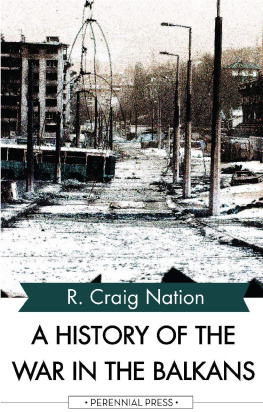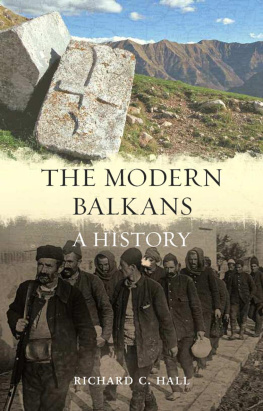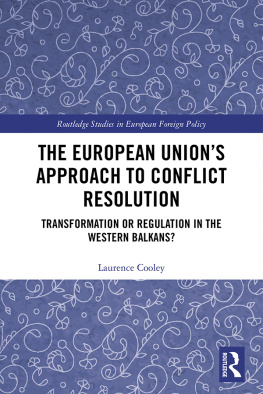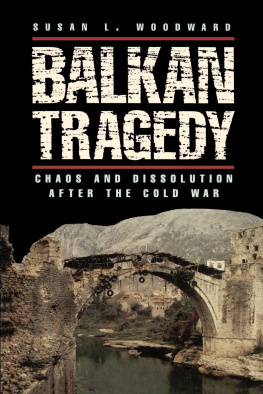TABLE OF CONTENTS
Figure 1. Map of the Balkan Region.
CHAPTER 1: THE BALKAN REGION IN WORLD POLITICS
~
On Board the Orient Express.
It has become common to use the term Balkan as a synonym for backwardness and bigotry. The most widely read and influential account of the region written during the 1990s portrays it as a repository of sadism and violence, haunted by the ghosts of implacable enmity. A prominent European diplomat, embittered by the failure of peacemaking efforts in Bosnia-Herzegovina, speaks with disdain of the subject of his mediation as a culture of violence within a crossroads civilization. Even the Turkish novelist Nedim Grsel, a friend of the region whose family originates from Ottoman skb (Skopje), laments that hatred between peoples condemned to coexist has become the destiny of the Balkans.
Such atavisms could be dismissed as Orientalist fantasies were it not for two inconvenient facts. First, the perception of the Balkans as a region torn by violence and ethnic strife has an objective foundation. From the emergence of the first national liberation movements among the Christian subjects of the Ottoman Empire in the early 19th century, Southeastern Europe has been a chronically unstable European sub-region.
Clashes with the Ottomans culminated in the Balkan wars of 1912-1913, and in both 20th century world wars the Balkans was a significant theater of operations. A phase of equilibrium during the Cold War could not be sustained after the collapse of communism, and the new Balkan war of the 1990s has been the only major European armed conflict since 1945 (with the partial exception of the Greek civil war of 1945-1947, really a continuation of struggles born during the Second World War). Second, even when they are exaggerated or inaccurate, perceptions matter. The fact that the Balkans is widely viewed as an area of ancient hatreds, irrespective of whatever real merit the argument may have, has shaped, and continues to shape, the international communitys approach toward the region and its problems.
What is the Balkans? The term itself, derived from Persian through Turkish, originally referred to a high house or mountain. It was incorporated into the phrase Balkan Peninsula by the German geographer Johann August Zeune in 1808 to call attention to the areas mountainous terrain, but did not come into common use until the mid-19th century. The pejorative connotation that the designation Balkan has taken on has led to resistance to its use, and in some ways the more neutral term Southeastern Europe is a preferable alternative. The Balkans, however, is more than just a peninsular extension of greater Europe. It is also a distinctive physical and cultural zone possessed of what Maria Todorova calls historical and geographic concreteness.
Most histories of the modern Balkans begin with a definition of the region based upon its physical characteristics. The Balkans is constituted as a peninsula, bounded by the Adriatic and Ionian Seas in the West, the Aegean Sea in the South, and the Black Sea in the East, and its ports of call have been a focus for commercial interaction since classical antiquity. Coastal areas and outlying island groups, with a more cosmopolitan background and milder Mediterranean climate, may be distinguished from inland regions, which are predominantly mountainous, relatively isolated, and subject to more severe continental weather patterns. Mountain barriers paralleling the coastline and an absence of navigable rivers cut the Balkan interior off from the sea. Unlike the Iberian and Italian Peninsulas, divided from the European heartland by the Pyrenees and the Alps, the Balkans opens to central Europe through the valley of the Danube and across the Pannonian plain. Internally, the region is fragmented by a series of mountain chainsthe Julien Alps in the north, the Dinaric and Pindus mountains stretching dorsally along the peninsulas western flank, the Carpathians in the northeast, the Balkan mountains (the Haemus range of classical antiquity) running east-west through the heart of Bulgaria, and the Rhodope mountains paralleling them in the south beyond the valley of the Maritsa River and falling away toward the Aegean. The lack of well irrigated lowlands suitable for intensive agriculture has been an impediment to population growth. Mountainous terrain has encouraged cultural differentiation, and contributed to the failure of attempts at integration.
As an exposed and strategically important area without a tradition of independent statehood, the Balkan Peninsula has served as a shatterbelt and point of confrontation between neighboring power complexesone source, externally imposed, of the propensity toward violence purported to be an indigenous trait. Sea, river, and overland lines of communication running adjacent to and across the region traverse a handful of critical chokepoints, which have been contested through the centuries. The route following the valley of the Danube from Central Europe to Belgrade, and continuing via the valley of the Morava to Ni, has always been a commercial and military artery of fundamental importance. From Ni one may proceed southward across the watershed into the valley of the Vardar (Axios) leading to the Aegean port of Thessalonica, southwestward across the pass of Thermopylae into Attica, or southeastward across the Dragoman Pass to Sofia, into the valley of the Maritsa to Plovdiv and Edirne, and beyond across the Thracian plain to Istanbul. There is no natural corridor attaching the Adriatic to the Balkan interior, though an east-west highway traversing the southern Balkans was constructed by the Romans beginning in 146A.D. This Via Egnatia was an extension, beyond the Adriatic, of the great Roman Via Appia linking Rome to Brindisi. It wound from what is today the Albanian port of Durrs across mountainous terrain through Elbassan, past Lake Okhrid and Bitola, and on to Thessalonica. Contemporary development projects feature efforts to recreate the Roman corridor as a modern highway net. Both north-south and east-west arteries cross the same critical strategic juncture in todays Republic of Macedonia.
Sea lines of communication through the Turkish Straits and the Strait of Otranto, paralleling the Anatolian coastline including the Dodecanese island group, and along the Albanian and Greek coasts, have been a focus for strategic rivalry into modern times, and the scene of a long list of famous naval encounters. Istanbul possesses a fine natural harbor, and the Greek ports of Thessalonica and Piraeus are friendly rivals as commercial ports in the eastern Mediterranean. The northern Adriatic includes serviceable harbors in Trieste, Koper, Rijeka, and Split, which have to some extent entered into competition for commercial traffic linking the Adriatic with the central European capitals of Vienna and Budapest. Further to the south, the port of Kotor (on the Gulf of Kotor in Montenegro) is modern Serbias only outlet to the sea. Albania possesses several suitable anchorages which are however woefully inadequate in terms of infrastructure. The breakup of modern Yugoslavia has made access to the Adriatic an especially important issue for land-locked Serbia, Macedonia, and Bosnia-Herzegovina. The Balkans geographic situation has made it an obligatory point of passage for migrants and invaders moving between Asia Minor and Europe. Centuries of ebb and flow have left the region one of the most diverse in the world, with distinct ethnic, linguistic, and confessional groups often living intermingled or in close proximity. The classic example of Balkan inter-culturality was once BosniaHerzegovina, where prior to the outbreak of war in 1992 only two towns could claim a pure ethnic composition with a single community representing more than 90 percent of the inhabitants, none of the twenty-five largest districts possessed a dominant community representing more than 50 percent of the population, and the rate of intermarriage among communities exceeded 25 percent (40 percent in urban areas). Despite the ravages of ethnic cleansing during the 1990s, the Balkans remains a repository of distinctive cultures coexisting in close proximity. Managing and organizing the regions diverse human geography is a basic strategic challenge.









